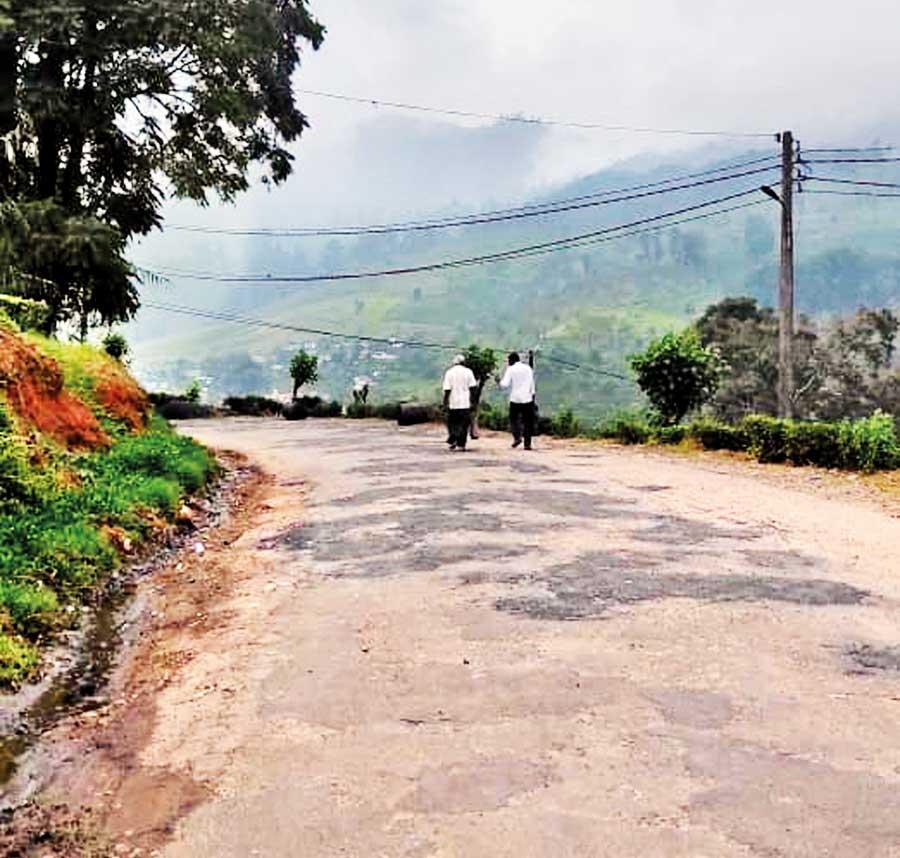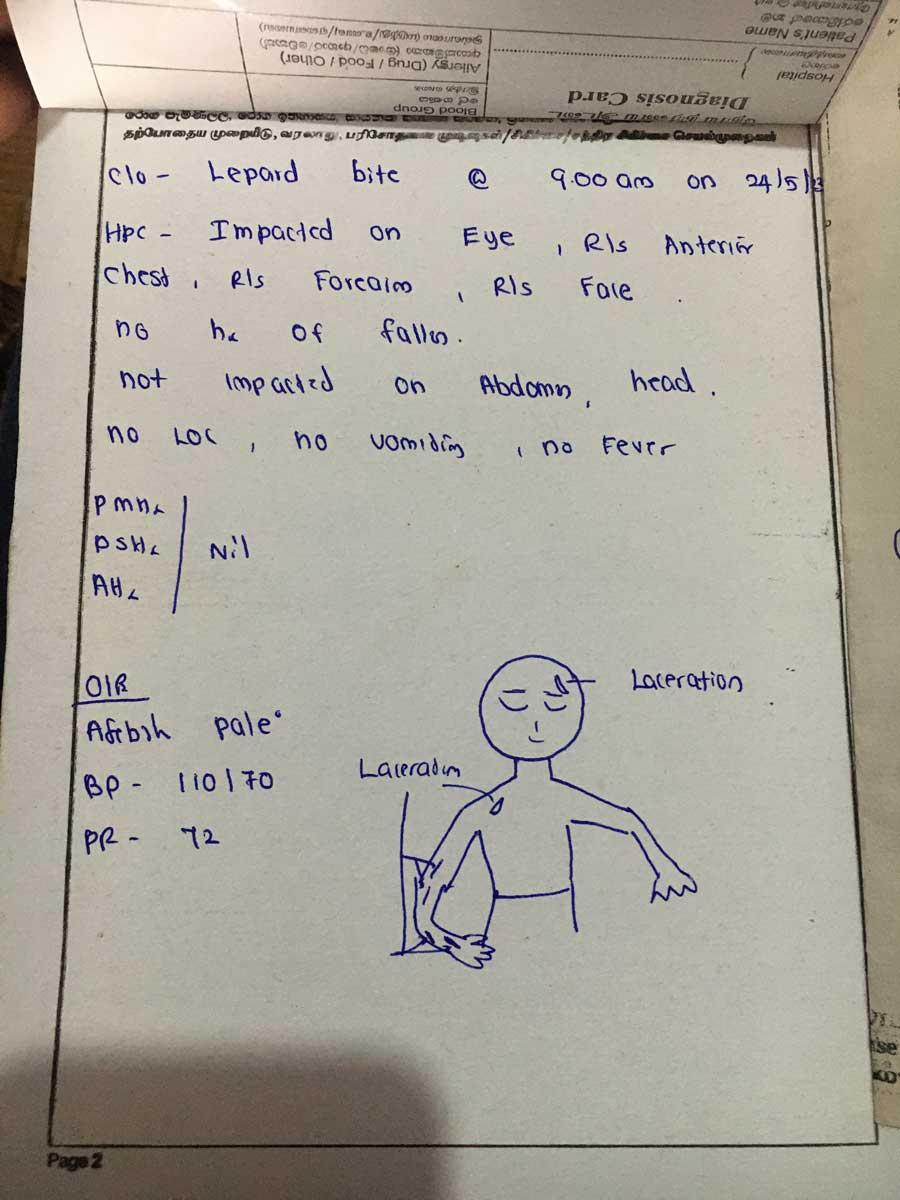Reply To:
Name - Reply Comment

Bridwell Estate Pix by T. K Mansoor
- Wildlife experts maintain that plantation companies must understand that leopards are now a part of their community
- Bridwell Estate is located at the heart of Bogawantalawa, home to a sizeable population of montane leopards
- Following the leopard incident, tea pickers now throw firecrackers before they start work
Dusk had already set in when we reached Bogawantalawa last Friday (June 2). What’s unique about the Central Highlands is that by about 5pm the climate turns misty and dark. We were on our way to meet Deva Prasath (39) from Bridwell Estate, Bogawantalawa who is a survivor of a recent leopard attack.
on our way to meet Deva Prasath (39) from Bridwell Estate, Bogawantalawa who is a survivor of a recent leopard attack.
With a broken hand and a hearty smile, Prasath was greeting his neighbours when we met him. He escorted us to his little abode in the middle of the estate. It had been around 9.00am when Prasath was ready to pluck the first few tea leaves for the day when he felt something pounce at him in seconds. “Something came at my face like a shopping bag and it took me a few seconds to realise that it was a fully grown leopard,” he recalled. “At that instant I lost my balance and fell down and before it could pounce on my neck I held my hand in defence. It bit some flesh off my hand and bolted away. That’s all that I remember,” he recalled.
“Even though I wanted to call out for help, the animal started to roar in such a way that it made me go deaf. It was like someone starting a generator. The animal started to roar and I couldn’t call my colleagues who were working nearby,” Prasath explained further.
“Even though I wanted to call out for help, the animal started to roar in such a way that it made me go deaf. It was like someone starting a generator. The animal started to roar and I couldn’t call my colleagues who were working nearby,”
Prasath, Victim of leopard attack
When asked if he had seen a leopard before, Prasath responded in the negative. “People have complained about their pet dogs going missing, but we didn’t take those incidents seriously.
|
Deva Prasath |
But now we are concerned,” he said. Medical reports indicate that the leopard had injured his face as well as the left side of the chest in addition to the bite wound it had inflicted upon him. Prasath is now being administered with the rabies vaccine and is under medication. As a tea picker Prasath earns an income that is barely enough to feed his only child and meet daily expenses. This is why his wife has found employment as a housemaid in the Middle East. Prasath is worried about his child with the uncertainty associated with his only profession.
Bridwell Estate is located at the heart of Bogawantalawa, home to a sizeable population of montane leopards. Following the incident, tea pickers now throw firecrackers before they start work at the estate, hoping that it would scare away the big cats.
When asked if the plantation company that owns the estate has installed snares to get rid of leopards, Prasath responded in the negative. Responding to a query on whether there have been any awareness programmes carried out to educate residents of the estate on coexisting with leopards Prasath said that no such programme has been carried out either. “We don’t want anybody to harm the animal. In fact the Wildlife Department should take some action. We fear plucking tea, but we have to earn a living as well. We now throw firecrackers before we go to the estate hoping that it would scare away the animal,” he said.
It is rather customary for tea pickers and contract workers living in these areas to intoxicate themselves with their daily income before they return home. But now, even that has to be done early
Following the leopard attack, people living in Bridwell Estate are now cautious about their whereabouts. It is rather customary for tea pickers and contract workers living in these areas to intoxicate themselves with their daily income before they return home. But now, even that has to be done early. While on our way back we met Vigneshwaran, Balasingham and Radhika; three friends who reside at Bridwell Estate. For them, the recent leopard attack is a warning sign. “We have seen leopards frequenting this area in the past. But there were seldom attacks on humans. Now that this incident took place, we have to be extra cautious. The leopards mostly visit the upper areas of the estate. But having said that people have seen a leopard and her cubs in the paddy fields near the town recently. Perhaps this area has a bigger population and we need to be cautious all the time,” Vigneshwaran added.
As we headed back to Hatton, there were hardly any people on the roads, laden amidst vast expanses of tea estates, sometimes punctuated with tiny streams and waterfalls that made up a magical scenery; something that only a hunting leopard could spoil.

People in Bogawantalawa returning home as dusk sets in
Communities and plantations as guardians for leopards
Statistics indicate that around 13 leopards were killed in 2022 by the use of snares. Over the years, around 50 leopards have been killed due to snaring. In response to the dwindling population of leopards, many wildlife organisations and researchers held discussions with plantation companies as means of convincing them to remove snares laid around their estates. While some programmes have been successful, more work needs to be done to ensure coexistence among estate workers and leopards.
“Leopards are an intrinsic part of their landscape,” explained Sethil Muhandiram, Founder of Leopocon, a non-profit Organisation in Sri Lanka, devoted exclusively for the conservation of leopards and their ecosystems. “We need to understand the importance of culture in how people and leopards share spaces even before plantations started. We need to educate residents; for example a few residents would know about how leopards behave, how they move through plantation or their solitary nature. This locally aquired knowledge can be used to educate larger communities and promote knowledge on leopards might be beneficial to both man and the beasts. Rather than putting thoughts from outside, the best way to educate communities is to build these lessons from inside. Plantation companies should focus on developing their own awareness programmes to promote coexistence. And these programmes can be highly impactful on children than adults,” he added.
“We need to understand the importance of culture in how people and leopards share spaces even before plantations started. We need to educate residents; for example a few residents would know about how leopards behave, how they move through plantation or their solitary nature,”- Sethil Muhandiram, Founder Leopocon
Speaking about leopards and their encounters with humans, Muhandiram further said that leopards usually fear humans. “Its their way of keeping the distance with the unknown but sometimes they can be curious about humans too and eventually they’ll adapt to human behaviour. But if human beings interrupt their hunt or interfere with their habitats they would become aggressive. In most cases, where leopards attacked humans there was a misunderstanding that leopards are to blame. But when leopards are found in human dominant landscapes, conflicts may arise due to attacks on humans or livestock and these can be mitigated by proper awareness and sharing of knowledge to understand leopards,” said Muhandiram
“With an abundance of livestock that could be easily picked and with plenty of dogs around, the behaviour of leopards is different within plantations compared to any other place in the country. While educating and raising awareness within the communities it’s a must to implement safety precautions for adults and children especially at night, about better livestock herding and so on. Plantation companies must work to promote a neutral perception and tolerance among people with regards to leopards and this will help to mitigate any negative interactions, thereby supporting human-leopard coexistence. They should not encourage any kind of retaliation towards the apex predator that may help them to keep balance within the ecosystem. After all plantation companies must understand that leopards are now a part of their community. Communities and plantations can be the best guardians of leopards and to do so, they must learn to coexist. This means that it’s important to understand leopards and their behaviours rather than looking at such a glamorous animal as enemies,” Muhandiram underscored.

Prasath’s diagnosis card issued by Dick Oya hospital